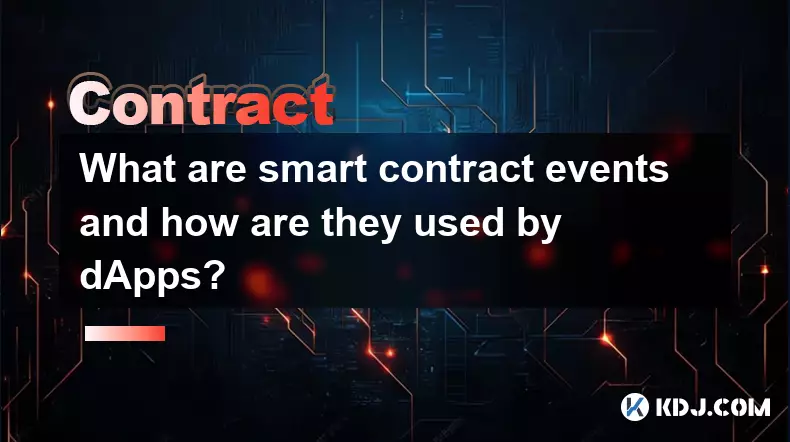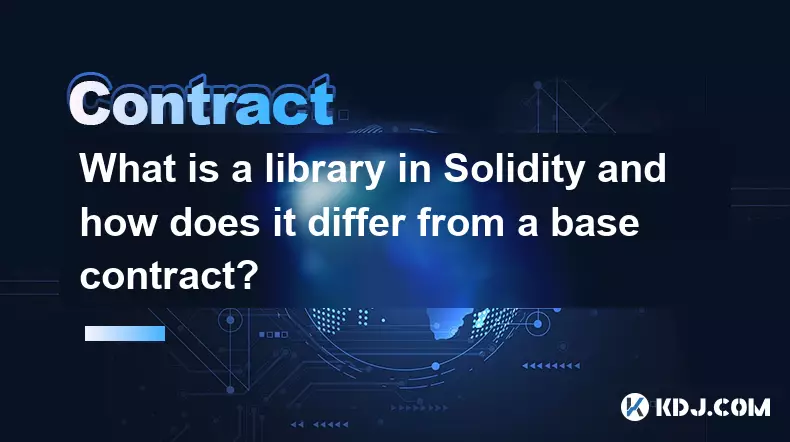-
 bitcoin
bitcoin $103128.103252 USD
-3.33% -
 ethereum
ethereum $3437.127692 USD
-4.86% -
 tether
tether $0.999700 USD
-0.02% -
 xrp
xrp $2.403993 USD
-5.73% -
 bnb
bnb $961.374676 USD
-4.11% -
 solana
solana $154.938665 USD
-8.18% -
 usd-coin
usd-coin $1.000113 USD
0.03% -
 tron
tron $0.298122 USD
0.30% -
 dogecoin
dogecoin $0.172428 USD
-5.76% -
 cardano
cardano $0.557625 USD
-7.13% -
 hyperliquid
hyperliquid $38.740701 USD
-6.51% -
 chainlink
chainlink $15.306051 USD
-7.51% -
 bitcoin-cash
bitcoin-cash $507.558648 USD
-3.26% -
 stellar
stellar $0.281899 USD
-6.74% -
 unus-sed-leo
unus-sed-leo $9.241811 USD
0.57%
What are smart contract events and how are they used by dApps?
Smart contract events are immutable logs emitted during function execution, enabling real-time dApp updates, efficient data indexing, and transparent on-chain tracking.
Nov 10, 2025 at 08:40 pm

Understanding Smart Contract Events
1. Smart contract events are signals emitted by a smart contract on the blockchain when specific conditions or functions are executed. These events serve as logs that record state changes, user interactions, or internal processes within the contract. Unlike regular data storage, events do not consume gas for retrieval by external applications and are stored in a special log structure on the Ethereum Virtual Machine (EVM) and compatible networks.
2. When a function inside a smart contract is triggered—such as transferring tokens, updating ownership, or finalizing a bet—an event can be programmed to fire alongside it. This allows developers to track what happened, when it happened, and who initiated it without needing to constantly query the entire contract state.
3. Events are defined using the event keyword in Solidity, followed by parameters that capture relevant data such as addresses, values, timestamps, or status flags. Once declared, they can be invoked within function bodies using the emit statement.
4. The data emitted through events is immutable and permanently recorded on the blockchain, making it ideal for audit trails, compliance reporting, and decentralized verification. Since this information is public, any party can listen to these events and verify actions independently.
Integration with dApps
1. Decentralized applications (dApps) rely heavily on smart contract events to update their user interfaces in real time. Instead of polling the blockchain repeatedly for changes—a process that is inefficient and resource-intensive—dApps use event listeners to receive instant notifications whenever a relevant action occurs.
2. Using Web3.js or Ethers.js libraries, frontend code subscribes to specific event types from deployed contracts. For example, a decentralized exchange dApp listens for a SwapExecuted event to immediately reflect updated token balances or trade history on the screen.
3. Events enable off-chain systems like indexing services (e.g., The Graph) to efficiently parse and organize blockchain data into queryable formats. Indexers monitor contract addresses, detect new events, and store structured data in databases so dApps can retrieve historical records quickly via GraphQL queries.
4. Backend servers used by dApps also subscribe to events via WebSocket connections to trigger automated workflows. A lending platform might react to a LoanDefaulted event by initiating liquidation procedures or sending alerts to risk management modules.
Use Cases in the Blockchain Ecosystem
1. In NFT marketplaces, events like Transfer, ApprovalForAll, or ItemListed notify users when assets change ownership or become available for purchase. These signals power real-time feeds and price tracking dashboards across platforms.
2. Yield farming protocols emit events when rewards are distributed, allowing third-party analytics tools to calculate user earnings accurately. Aggregators use this data to rank farms by APY and display performance metrics across multiple chains.
3. Governance systems in DAOs emit events such as ProposalCreated, VoteCast, or QuorumReached. Community dashboards track these events to keep members informed about voting progress and decision outcomes.
4. Oracles and cross-chain bridges utilize events to synchronize state between blockchains. A bridge contract may emit a TokensLocked event on one chain, which triggers minting on another after validation by relayers.
Frequently Asked Questions
What is the difference between a return value and an event in a smart contract?A return value is only accessible during the same transaction call and cannot be accessed later. An event persists on-chain and can be queried at any time by external applications, even long after the transaction has been confirmed.
Can events be modified or deleted after being emitted?No. Once an event is logged on the blockchain, it becomes part of the immutable ledger. It cannot be altered, removed, or suppressed, ensuring transparency and trustlessness in system behavior.
Do smart contract events cost gas?Yes, emitting an event consumes gas because it writes data to the blockchain’s log storage. However, this cost is significantly lower than storing equivalent data in contract variables, making events a gas-efficient way to expose information.
How do I filter events by specific parameters?Using libraries like Ethers.js, you can create filters based on indexed event parameters. Indexed fields allow fast lookup, enabling dApps to listen only to events related to a particular user address or token ID, reducing unnecessary data processing.
Disclaimer:info@kdj.com
The information provided is not trading advice. kdj.com does not assume any responsibility for any investments made based on the information provided in this article. Cryptocurrencies are highly volatile and it is highly recommended that you invest with caution after thorough research!
If you believe that the content used on this website infringes your copyright, please contact us immediately (info@kdj.com) and we will delete it promptly.
- DESK Token, Tokenized Real Estate, and Venture Hub: A New Era in Digital Assets
- 2025-11-12 16:55:02
- JPM Coin, Blockchain, and Public Tokens: The Future of Institutional Finance?
- 2025-11-12 17:10:00
- Ethereum's Whale Watch: Upgrade Incoming!
- 2025-11-12 17:10:00
- DOGE: Analyzing the Price and Potential – Will Dogecoin Reach $1?
- 2025-11-12 17:10:02
- JPMD, USD Token, and Base Network: JPMorgan's Blockchain Leap
- 2025-11-12 17:10:02
- Treasury Plays Evolve: Beyond MSTR with Blockchain Engineering
- 2025-11-12 17:20:01
Related knowledge

What is a Denial of Service (DoS) attack in a smart contract and what are its common forms?
Nov 10,2025 at 05:20am
Understanding Denial of Service in Smart Contracts1. A Denial of Service (DoS) attack in the context of smart contracts refers to a scenario where a m...

What is a cryptographic nonce used for in transaction signing?
Nov 11,2025 at 05:59am
Understanding Cryptographic Nonces in Blockchain Transactions1. A cryptographic nonce is a random or pseudo-random number used only once in the contex...

How does inheritance work in Solidity smart contracts?
Nov 11,2025 at 10:40pm
Inheritance in Solidity: Building Modular Smart Contracts1. Inheritance in Solidity allows one contract to adopt the properties and functions of anoth...

What is a Minimal Proxy Contract (EIP-1167) and how does it save gas on deployment?
Nov 12,2025 at 11:39am
What is a Minimal Proxy Contract (EIP-1167)?1. A Minimal Proxy Contract, standardized under Ethereum Improvement Proposal (EIP) 1167, is a lightweight...

What is a library in Solidity and how does it differ from a base contract?
Nov 12,2025 at 09:19am
Understanding Libraries in Solidity1. A library in Solidity is a special type of contract designed to hold reusable functions that can be shared acros...

How do you safely send Ether to another contract?
Nov 09,2025 at 06:40pm
Sending Ether to Smart Contracts: Key Considerations1. Verify that the receiving contract has a payable fallback function or a designated payable func...

What is a Denial of Service (DoS) attack in a smart contract and what are its common forms?
Nov 10,2025 at 05:20am
Understanding Denial of Service in Smart Contracts1. A Denial of Service (DoS) attack in the context of smart contracts refers to a scenario where a m...

What is a cryptographic nonce used for in transaction signing?
Nov 11,2025 at 05:59am
Understanding Cryptographic Nonces in Blockchain Transactions1. A cryptographic nonce is a random or pseudo-random number used only once in the contex...

How does inheritance work in Solidity smart contracts?
Nov 11,2025 at 10:40pm
Inheritance in Solidity: Building Modular Smart Contracts1. Inheritance in Solidity allows one contract to adopt the properties and functions of anoth...

What is a Minimal Proxy Contract (EIP-1167) and how does it save gas on deployment?
Nov 12,2025 at 11:39am
What is a Minimal Proxy Contract (EIP-1167)?1. A Minimal Proxy Contract, standardized under Ethereum Improvement Proposal (EIP) 1167, is a lightweight...

What is a library in Solidity and how does it differ from a base contract?
Nov 12,2025 at 09:19am
Understanding Libraries in Solidity1. A library in Solidity is a special type of contract designed to hold reusable functions that can be shared acros...

How do you safely send Ether to another contract?
Nov 09,2025 at 06:40pm
Sending Ether to Smart Contracts: Key Considerations1. Verify that the receiving contract has a payable fallback function or a designated payable func...
See all articles


























![[4K 60fps] no care by crashpancake2 (1 Coin) [4K 60fps] no care by crashpancake2 (1 Coin)](/uploads/2025/11/12/cryptocurrencies-news/videos/6913a8862890b_image_500_375.webp)















































